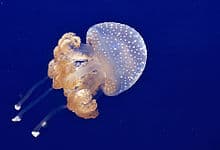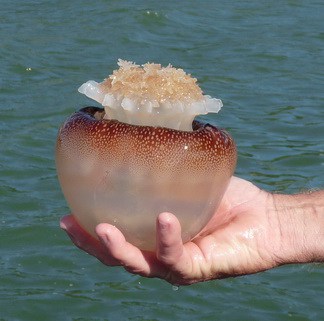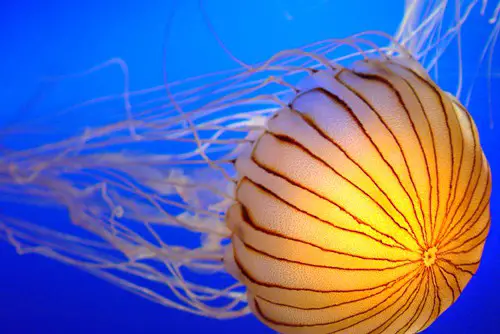Jellyfish are free-swimming marine mammals that are found on the top and bottom of the ocean. They are 95% water, vary in size, and like Sharks, in the ocean, can be very dangerous as everyone knows. But can you survive at sea by eating raw jellyfish?
Yes, a species of jellyfish called Rhizotomies is a type of Jellyfish that is processed worldwide & used as a food source all over Asia. They’re low in fat, rich in protein and collagen & contain essential omega-3 and omega-6 unsaturated fatty acids.
In 2005 two boys survived a week-long ordeal lost at sea, by eating raw Jellyfish plucked from the ocean and drinking rainwater. When the boys drifted out to sea off the coast of the Carolinas, it was unknown to them that Jellyfish were becoming a delicacy and healthy food all around the world.
Can You Eat Jellyfish Raw

A species of jellyfish called Rhizostomae is the kind of Jellyfish that is processed and used as a food source. They are identified by having no tentacles or any structures at the bell’s edge at the head of the Jellyfish.
They have eight highly branched oral arms, along which there are suctorial mini-mouth orifices. (This is in contrast to other jellyfish which have four of these arms.) These oral arms become fused as they approach the central part of the jellyfish.
People in Japan and China have been eating types of Jellyfish since the year 300 and people in Japan, Southeast Asia, and Korea are the largest consumers in the world. To process them for consumption:
- After Jellyfish are caught they have to be cured and dried out within 6 hours.
- The round head or the Umbrella of the jellyfish is cut off and the mucus is removed.
- Wash the Umbrella and soak it in a brine of salt, water, and alumn. Alumn is a crystalline powder that is a permeating aid. Rhizostomae Jellyfish
- Do this a few more times and dry the Umbrella even further.
- Rinse and then soak it to a flash boil on the stove
- Ready to serve as a delicacy or used in a recipe or used for medicinal purposes.
They are used in salads and in Sushi and can be found now in ice cream and all kinds of snacks in parts of Japan. Normally they are processed and eaten as a dried product. All told, there are some 1,500 jellyfish species: blue blubbers, bushy bottoms, fire jellies, and jumbles. Cannonballs, sea walnuts. Pink meanies, stinging cauliflowers. Hair jellies, snotty. Purple people eaters and many more.
The bell-shaped jellies are distantly related to corals and anemones that launched their lifestyle long, long ago. Exquisite jellyfish fossils found recently in Utah display reproductive organs, muscle structure, and intact tentacles; the jelly fossils, the oldest discovered, date back more than 500 million years when Utah was a shallow sea. By contrast, fish evolved only about 370 million years ago. These guys have been around for a while.
According to the Smithsonian Insitute: About a dozen jellyfish varieties with firm bells are considered desirable food. Stripped of tentacles and scraped of mucous membranes, jellyfish are typically soaked in brine for several days and then dried. In Japan, they are served in strips with soy sauce and vinegar.
The Chinese have eaten jellies for 1,000 years (jellyfish salad is a wedding banquet favorite). Lately, in an apparent effort to make lemons into lemonade, the Japanese government has encouraged the development of haute jellyfish cuisine—jellyfish caramels, ice cream and cocktails—and adventuresome European chefs are following suit.
The Smithsonian. com A Taste Of Jellyfish
The main edible variety of Jellyfish in U.S. waters is cannonball jellies, which are found on the Atlantic Coast from North Carolina to Florida and in the Gulf of Mexico. They scored quite high on a “hedonic scale” of color and texture in a study led by Auburn University. Another scientific paper hailed jellyfish flesh—which is 95 percent water, a few grams of protein, the barest hint of sugar, and, once dried, only 18 calories per 100-gram serving as “the ultimate modern diet food.”
 Most people who have traveled to Asia have tried jellyfish in Sushi restaurants and in salads in the best places to eat in Tokyo or Korea. Just like raw fish and other critters found in the ocean, most need an acquired taste.
Most people who have traveled to Asia have tried jellyfish in Sushi restaurants and in salads in the best places to eat in Tokyo or Korea. Just like raw fish and other critters found in the ocean, most need an acquired taste.
The raw jellyfish taste salty and the texture is pretty much NOT like you think it would be.
A lot of restaurants in China use them to make noodles and supposedly, that’s what they taste like. Some people think that the spices and ingredients used for the jellyfish recipe are what they taste like.
Jellyfish is brainless formless and spineless and when chefs use the curing process it removes most of the water and firms the meat up to a good texture. It can be cut in long starns and tossed with sesame oil and soy sauce or served raw and cold.
The bottom line is that everyone that tries raw or cooked Jellyfish, has a different opinion of what it tastes like. Most agree that it’s salty and watery, and takes on the flavor of what it’s being prepared with along with the spices and sauces that are added to it. The surprising thing is that it’s Crunchy. Some enthusiasts compare the taste of jellyfish to fresh squid. Some are reminded of cucumbers. Others think of salty rubber bands.”
Jellyfish Nutrition
Jellyfish are 95% water and 5 percent protein. They are very low in calories and are considered healthy food. Medical Practitioners in Asia have been using them for Centuries to treat patients for assortments of ailments from Arthritis to Heart Disease.
Also eating jellyfish has a sustainable purpose. The overpopulated ocean jellyfish eat fish eggs and plankton which would hurt the ocean’s environment. So eating them is a good thing. They are healthy for the consumer too. They’re low in fat and rich in protein and collagen.
The little fat it contains is the essential proteins and unsaturated fatty acids.
There is always a chance you take when you eat raw uncooked seafood. Fans of Sushi say perhaps we should ask what’s the point of cooking any of it? If the fish, or other seafood, is clean and fresh, there is little danger in eating it. But there may be parasites to deal with, and bacteria grow quickly on anything dead and aging.
So if you need to eat it fast. Don’t let it sit around like any other seafood it will go bad. If you are lost at sea or in a Gourmet Restaurant, give it a try.

References:
The Smithsonian. com A Taste Of Jellyfish
